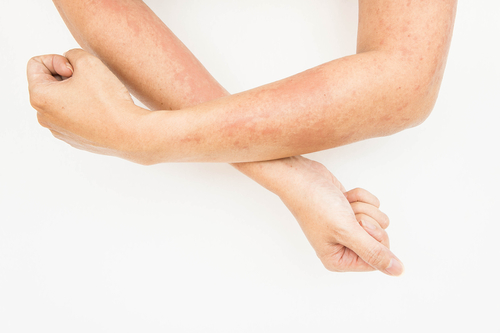High Levels of IL-6 Correlate with More Severe Skin Disease in SSc, Study Shows

Levels of a pro-inflammatory signaling molecule, called interleukin (IL)-6, are significantly high in skin lesions and blood samples of patients with systemic sclerosis (SSc), especially among those with diffuse cutaneous SSc, a small Japanese study reports.
The study, “IL-16 expression is increased in the skin and sera of patients with systemic sclerosis,” was published in the journal Rheumatology.
IL-6 is a cytokine — an immune system signaling molecule — that has been shown to promote inflammation. Evidence suggests that the levels of IL-6 are increased in people with SSc.
Now, researchers at Japan’s Kumamoto University examined the levels of IL-6 in lesions obtained from 10 SSc patients (four with diffuse cutaneous SSc and six with limited cutaneous SSc), and in blood samples of 57 patients (26 with diffuse and 31 with limited cutaneous SSc. They then evaluated how the levels of IL-6 correlated with clinical symptoms.
Researchers used blood samples from healthy age- and sex-matched volunteers as controls.
Results showed that the levels of lymphocytes, key cells of the immune system, positive for IL-6 were more abundant in skin tissues of patients with SSc. The number of IL-6 positive lymphocytes when taking into account all lymphocytes was significantly higher in skin lesions of patients with diffuse cutaneous SSc (43.9%) than in those with limited cutaneous SSc (29.1%).
Researchers then measured the levels of IL-6 in blood samples of 57 SSc patients, and compared them with those of controls. In SSc patients, the levels of IL-6 were significantly higher (297.0 pg/ml) than controls (194.9 pg/ml).
Moreover, increased IL-16 levels in the blood of SSc patients correlated with a diagnosis of diffuse cutaneous SSc, and with more severe skin thickening using the modified Rodnan skin score (mRSS). Additionally, higher Il-6 also correlated with other skin signs, including redness (erythema) and pigmentation.
Overall, “these results of the correlation between the increased IL-16 levels and the severe skin symptoms suggest that IL-16 could play a key role in skin fibrosis. Moreover, the result that the overexpression of IL-16 was identified not only in the skin, but also in the serum, could indicate the systemic activation of IL-16 in patients with SSc,” the researchers said.
Further research with larger samples is warranted; nonetheless, based on the results, the team suggested that “IL-16 could be useful as a biomarker for the diagnosis of SSc,” and that reducing the levels of IL-6 “may be effective for the treatment of SSc in the future.”






